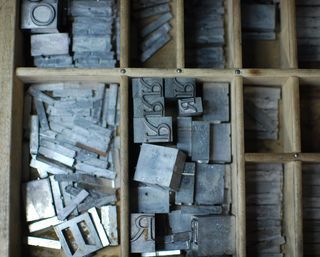Craftsmanship
For a couple of weeks now, I've been taking a letterpress class at the Minnesota Center for Book Arts. It's the introductory course, which means we're setting lead type, creating linocuts, and printing broadsheets on a Vandercook proof press. Last time, I spent three hours doing by hand something I could do much better on the computer in about ten seconds. Cool, huh?
As a matter of fact, it is. I'm not sure how many teenagers in the 1980s could list "typographer" as their first summer job, but that was me. In the days before the desktop revolution, I learned on what was still called a Linotype machine, although it had a tiny green display screen, a WYSIWIG monitor you could send code to for display, and a printer that used photography chemicals I had to mix myself. It cost $50,000 used, I was told. In the early 90s, I saw the same machine shrink-wrapped on a pallet in a warehouse. They couldn't even give it away.
By comparison, letterpress printing is a lot of fun. I started out by setting a line in 72 pt. Caslon. It turns out a case full of 72 pt. lead type weighs as much as, well, a big wooden tray filled with blocks of lead. Before long, I decided I liked 18 pt. Goudy Modern a lot more. The trick for composing is to work left to right, but upside down (remember, the type is arranged as the reverse image of what you want to see on the page). Suddenly phrases like "mind your p's and q's" (or for that matter, your d's and b's) aren't abstractions anymore. I discovered twice what it means to be, quite literally, "out of sorts" -- i.e., without enough of a particular lead character (a "sort") to finish your layout. And of course, I spaced my lines using thin sheets of lead: hence, "leading."
As a bibliophile, while I'm doing all this, I find myself thinking about the private press movement, an early twentieth century phenomenon in which some Arts & Crafts movers and shakers got their hands on printing presses and starting making lots of pretty and meaningful books. The desktop printing revolution kind of sparked similar things, and I suppose you could argue digital printing (and now e-printing) are having a similar effect -- the only difference being the pretty, well-made part of the equation. What I'm longing for as I go through the motions of an earlier kind of craftsmanship is an applicable craft sense for today, a means for not just of doing things cheaply, but doing them well.




